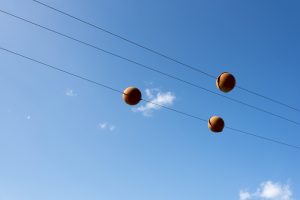Power Line Balls
The colored balls hanging from the power lines are visibility markers for pilots. Electric companies in Texas and around the country use these balls on power lines to alert pilots of hanging wires.
You’ll most often find balls on electric lines near airports, crossing canyons, over lakes, or wide-open expansions of land, where the power lines may blend in with the open land.

History of Power Line Balls
The idea of placing balls on electric lines began in the early 1970s. Winthrop Rockefeller, the governor of Arkansas at the time, noticed how close the power lines were to his plane when landing.
Rockefeller happened to be traveling with Edward Holland, the head of the Department of Aeronautics of Arkansas, and ordered him to find a way to make it easier for low-flying aircraft pilots to notice electrical wires.
Holland enlisted an engineer to the task, and by the 1980s, visibility markers were commonplace across the United States.
What Do Visibility Markers Look Like?
Visibility markers resemble large balls, usually orange, yellow, or red in color.
The balls are a minimum of 36 inches in diameter on power lines located near lakes, rivers, or canyons. The aerial marker balls on shorter structures (under 50 feet) are much smaller, with a minimum of 20 inches in diameter.
You may also notice differences in colors, which provide airplane and helicopter pilots with important information about their location. A power line with fewer than four visibility markers uses an aviation orange color. Visibility markers with a greater range in colors between orange, yellow, and white tell a pilot how close they’re getting to the area.
Power Line Ball Rules
You’ll find balls on power lines in all 50 states.
The Federal Aviation Administration (FAA) requires bright orange, white, or yellow power line balls on the top wire of all hard-to-see areas for pilots. The FAA also specifically requires a power line ball to be a maximum of 25 feet from any nearby wires that don’t have a power line ball.
You may also notice lighted or unlighted power line balls, which are used to alert pilots to approaching hazards.
Electric companies with higher voltage transmission power lines (anything over 69 kV) are usually higher up in the air on taller catenary supports and hold lighted power line balls. Energy providers with less than 69 kV power lines are on shorter catenary supports and use unlighted power line balls.
Today, all power companies in Texas and beyond use visibility markers. The FAA estimates that balls on power lines have saved many lives since the 1980s. The next time you drive near a valley, airport, or mountain range, keep an eye out for these brightly colored visibility markers and then share this small tidbit of information with others.

